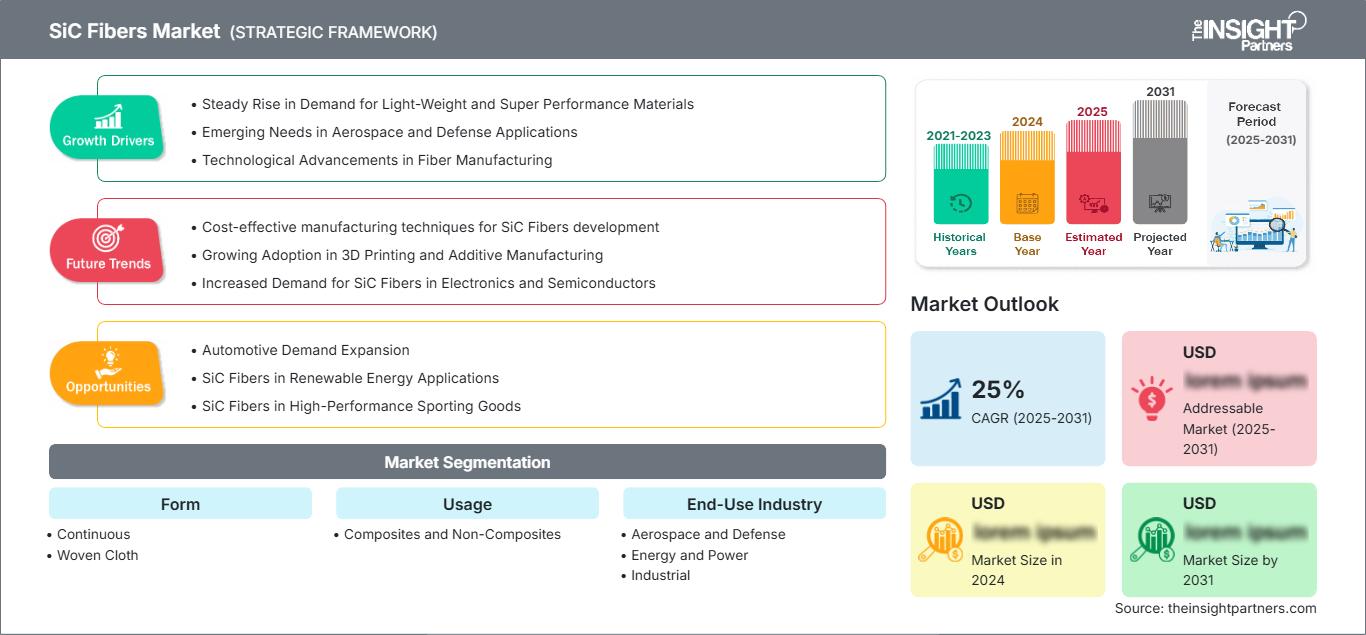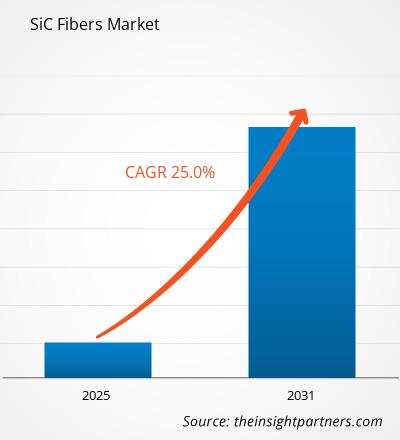Der Markt für SiC-Fasern wird bis 2031 voraussichtlich ein Volumen von 3,57 Milliarden US-Dollar erreichen. Für den Zeitraum 2025–2031 wird ein jährliches Wachstum von 26,2 % erwartet.
Der Markt für SiC-Fasern wird nach Form (Endlosfasern, Gewebe und Sonstige), Verwendung (Verbundwerkstoffe und Nicht-Verbundwerkstoffe), Endverbrauchsbranche (Luft- und Raumfahrt, Energie, Industrie und Sonstige) sowie Region (Nordamerika, Europa, Asien-Pazifik, Naher Osten und Afrika sowie Süd- und Mittelamerika) analysiert. SiC-Fasern bestehen hauptsächlich aus Siliciumcarbid-Molekülen mit einem Durchmesser von in der Regel 5 µm bis 50 µm. Hohe Temperaturbeständigkeit, geringere Wärmeausdehnung, niedrigere Dichte, höhere Oxidationsbeständigkeit, geringere Permeabilität, geringes Gewicht, höhere Festigkeit und bessere Wärmeleitfähigkeit sind die Schlüsseleigenschaften von SiC-Fasern, die zu ihrer Beliebtheit in der Luft- und Raumfahrt, der Energiewirtschaft und der Industrie beitragen.
Zweck des Berichts
Der Bericht „SiC Fibers Market“ von The Insight Partners beschreibt die aktuelle Marktlage und das zukünftige Wachstum, die wichtigsten Triebkräfte, Herausforderungen und Chancen. Er bietet Einblicke für verschiedene Marktteilnehmer, wie zum Beispiel:
- Technologieanbieter/Hersteller: Um die sich entwickelnde Marktdynamik zu verstehen und potenzielle Wachstumschancen zu erkennen, um fundierte strategische Entscheidungen treffen zu können.
- Investoren: Um eine umfassende Trendanalyse hinsichtlich Marktwachstumsrate, Finanzprognosen und Chancen entlang der Wertschöpfungskette durchzuführen.
- Regulierungsbehörden: Um Richtlinien zu regulieren und Aktivitäten auf dem Markt zu überwachen, mit dem Ziel, Missbrauch zu minimieren, das Vertrauen der Investoren zu wahren und die Integrität und Stabilität des Marktes zu gewährleisten. Marktsegmentierung für SiC-Fasern: Form
- Endlos
- Gewebt
Verwendung
- Verbundwerkstoffe und Nicht-Verbundwerkstoffe
Endverbrauchsbranche
- Luft- und Raumfahrt/Verteidigung
- Energie/Strom
- Industrie
Geografie
- Nordamerika
- Europa
- Asien-Pazifik
- Süd- und Mittelamerika
- Naher Osten und Afrika
Passen Sie diesen Bericht Ihren Anforderungen anSie erhalten kostenlos Anpassungen an jedem Bericht, einschließlich Teilen dieses Berichts oder einer Analyse auf Länderebene, eines Excel-Datenpakets sowie tolle Angebote und Rabatte für Start-ups und Universitäten.
Markt für SiC-Fasern: Strategische Einblicke

-
Holen Sie sich die wichtigsten Markttrends aus diesem Bericht.Dieses KOSTENLOSE Beispiel umfasst Datenanalysen, die von Markttrends bis hin zu Schätzungen und Prognosen reichen.
Wachstumstreiber für den Markt für SiC-Fasern
- Stetig steigende Nachfrage nach leichten und hochleistungsfähigen Materialien: Siliziumkarbidfasern (SiC) zeichnen sich durch ihre mechanischen Eigenschaften aus, insbesondere durch Zugfestigkeit, thermische Stabilität und geringe Dichte. Daher eignen sie sich für Anwendungen in der Luft- und Raumfahrt, der Automobilindustrie und der Verteidigungsindustrie. Die steigende Nachfrage nach leichten und leistungsstarken Materialien in den genannten Sektoren, insbesondere für Hochtemperaturanwendungen, hat dazu geführt, dass sich SiC-Fasern schnell zu einem der wichtigsten Materialbestandteile in modernen Verbundwerkstoffen entwickelt haben.
- Neue Anforderungen in der Luft- und Raumfahrt sowie der Verteidigungsindustrie: Diese SiC-Fasern erfüllen effektiv die Anforderungen an Bauteile mit geringem Gewicht und hoher Festigkeit für Anwendungen wie Triebwerks- und Turbinenschaufelteile in der Luft- und Raumfahrt sowie der Verteidigungsindustrie. Der aktuelle Fokus auf verbesserte Treibstoffeffizienz bei gleichzeitiger Gewichtsreduzierung in der Flugzeugindustrie führt zu einer zunehmenden Abhängigkeit von Branchen, die SiC-Fasern für Hochtemperatur- und Hochbeanspruchungsanwendungen benötigen, und damit zu einem wachsenden Markt. Technologische Fortschritte in der Faserherstellung: Zu diesen Veränderungen gehört die Entwicklung effektiverer und kostengünstigerer Verfahren zur Herstellung von SiC-Fasern. Dadurch wird das Material leichter verfügbar. Dank der neuen Technologie und der niedrigeren Produktionskosten könnten SiC-Fasern schon bald für viele ihrer potenziellen Anwendungen kommerziell rentabel sein, was zu einem verstärkten Marktwachstum und neuen Chancen in verschiedenen Bereichen führen wird. Zukunftstrends des SiC-Fasermarktes: Kosteneffiziente Fertigungstechniken für die Entwicklung von SiC-Fasern: Die Nachfrage nach SiC-Fasern wird voraussichtlich steigen und dadurch Verbesserungen im Produktionsprozess hin zu qualitativ hochwertigen Produkten zu niedrigen Kosten vorantreiben. Dies beinhaltet Optimierungen auf Basis von Kosteneinsparungen bei Techniken wie der chemischen Gasphaseninfiltration (CVI) und der lasergestützten chemischen Gasphasenabscheidung (LCVD). Dadurch wird der Preis für SiC-Faserprodukte für eine Vielzahl kommerzieller Anwendungen gesenkt, die von der Automobil- über die Energie- bis zur Luft- und Raumfahrtindustrie reichen. Zunehmende Verbreitung im 3D-Druck und der additiven Fertigung: SiC-Fasern werden in der 3D-Druckindustrie, insbesondere für Hochleistungsbauteile, bald vermehrt eingesetzt. Mit fortschreitender Technologieentwicklung im Bereich der additiven Fertigung steigt auch der Bedarf an SiC-Fasern für die Herstellung komplexer, leichter und hochbeständiger Strukturen. Daher werden sie vermehrt in der Luft- und Raumfahrt, der Automobilindustrie und im Verteidigungsbereich eingesetzt, da hier höchste Anforderungen an Toleranz und Materialfestigkeit gestellt werden. Steigende Nachfrage nach SiC-Fasern in der Elektronik und Halbleiterindustrie: Die Siliziumkarbid-Revolution in der Elektronik, insbesondere in der Halbleiterindustrie, eröffnet neue Anwendungsgebiete für SiC-Fasern. Diese Fasern zeichnen sich durch hervorragende Wärmeleitfähigkeit und Hochspannungsfestigkeit aus und eignen sich daher optimal für Anwendungen in der modernen Elektronik, in Energiesystemen und Stromnetzen. Darüber hinaus wird die Einführung elektronischer Geräte der nächsten Generation das Wachstum in diesem Bereich weiter ankurbeln.
Marktchancen für SiC-Fasern
- Expandierende Nachfrage in der Automobilindustrie: Da sich die Automobilindustrie rasant in Richtung Elektromobilität und Leichtbau entwickelt, birgt SiC großes Potenzial. Der potenzielle Einsatz von SiC-Fasern in Elektromotorkomponenten, Batterien und Wärmemanagementsystemen ist sehr attraktiv und trägt zur Steigerung von Leistung und Effizienz von Elektrofahrzeugen bei. Hersteller erforschen SiC-Fasern im Hinblick auf die hohe Leistung und Energieeffizienz von Fahrzeugen, die vom wachsenden Markt nachgefragt werden.
- SiC-Fasern in Anwendungen für erneuerbare Energien: Die Entwicklung effizienterer und langlebigerer Komponenten für Turbinen und Energiesysteme wird durch SiC-Fasern im Einklang mit dem Wachstum erneuerbarer Energietechnologien wie Solar- und Windenergie vorangetrieben. Dank ihrer hohen Wärmeleitfähigkeit, Verschleißfestigkeit und ausgezeichneten Festigkeit unter extremen Bedingungen eignen sich SiC-Fasern ideal zur Leistungssteigerung in Anwendungen für erneuerbare Energien. SiC-Fasern in Hochleistungssportartikeln: Die Verwendung dieser Fasern in der Produktion von Ausrüstung für Hochleistungssportarten, wie z. B. Fahrräder, Helme und Schutzausrüstung, ist eine der vielversprechendsten Anwendungen. Ihr geringes Gewicht, ihre Festigkeit und ihre Stoßfestigkeit können die Sicherheit und Leistungsfähigkeit der Ausrüstung im Sport verbessern. Dies dürfte auch zu einer breiteren Anwendung von SiC-Fasern in nicht-traditionellen Segmenten führen.
SiC-Fasermarkt
Die regionalen Trends und Einflussfaktoren auf den Markt für SiC-Fasern im gesamten Prognosezeitraum wurden von den Analysten von The Insight Partners ausführlich erläutert. Dieser Abschnitt behandelt außerdem die Marktsegmente und die geografische Verteilung des Marktes für das Management von Herzrhythmusstörungen in Nordamerika, Europa, Asien-Pazifik, dem Nahen Osten und Afrika sowie Süd- und Mittelamerika.
Umfang des Marktberichts zu SiC-Fasern
By Verwendung- Verbundwerkstoffe und Nicht-Verbundwerkstoffe
- Luftfahrt und Verteidigung
- Energie und Strom
- Industrie
- Nordamerika
- Europa
- Asien-Pazifik
- Süd- und Mittelamerika
- Naher Osten und Afrika
- Großbritannien
- Deutschland
- Frankreich
- Russland
- Italien
- Restliches Europa
- China
- Indien
- Japan
- Australien
- Restlicher Asien-Pazifik
- Brasilien
- Argentinien
- Restliches Süd- und Mittelamerika
- Südafrika
- Saudi-Arabien
- Vereinigte Arabische Emirate
- Restlicher Naher Osten und Afrika
Berichtsattribut Einzelheiten Marktgröße in 2024 US$ XX Billion Marktgröße nach 2031 US$ 3.57 Billion Globale CAGR (2025 - 2031) 26.2% Historische Daten 2021-2023 Prognosezeitraum 2025-2031 Abgedeckte Segmente By Form - kontinuierlicher
- gewebter Stoff
Abgedeckte Regionen und Länder Nordamerika - USA
- Kanada
- Mexiko
Marktführer und wichtige Unternehmensprofile - SiC Fibers Market
- American Elements
- BJS Ceramics GmbH
- COI Ceramics, Inc.
- General Electric Company
- Haydale Technologies Inc.
- Free Form Fibers
- NGS Advanced Fibers Co., Ltd.
- Specialty Materials, Inc.
SiC-Fasern: Marktteilnehmerdichte – Auswirkungen auf die Geschäftsdynamik
Der Markt für SiC-Fasern wächst rasant, angetrieben durch die steigende Nachfrage der Endverbraucher. Gründe hierfür sind unter anderem sich wandelnde Verbraucherpräferenzen, technologische Fortschritte und ein wachsendes Bewusstsein für die Vorteile des Produkts. Mit steigender Nachfrage erweitern Unternehmen ihr Angebot, entwickeln innovative Lösungen, um den Verbraucherbedürfnissen gerecht zu werden, und nutzen neue Trends, was das Marktwachstum zusätzlich beflügelt.

- Holen Sie sich die Markt für SiC-Fasern Übersicht der wichtigsten Akteure
Wichtigste Verkaufsargumente
- Umfassende Abdeckung: Der Bericht bietet eine umfassende Analyse der Produkte, Dienstleistungen, Typen und Endnutzer des SiC-Fasermarktes und vermittelt so ein ganzheitliches Bild.
- Expertenanalyse: Der Bericht basiert auf dem fundierten Wissen von Branchenexperten und Analysten.
- Aktuelle Informationen: Der Bericht gewährleistet Geschäftsrelevanz durch die Berücksichtigung aktueller Informationen und Datentrends.
- Anpassungsmöglichkeiten: Dieser Bericht kann an spezifische Kundenanforderungen angepasst werden und sich optimal in die Geschäftsstrategien integrieren.
Der Forschungsbericht zum SiC-Fasermarkt kann somit maßgeblich dazu beitragen, das Branchenszenario und die Wachstumsaussichten zu entschlüsseln und zu verstehen. Auch wenn einige berechtigte Bedenken bestehen, überwiegen die Vorteile dieses Berichts insgesamt die Nachteile.
- Historische Analyse (2 Jahre), Basisjahr, Prognose (7 Jahre) mit CAGR
- PEST- und SWOT-Analyse
- Marktgröße Wert/Volumen – Global, Regional, Land
- Branchen- und Wettbewerbslandschaft
- Excel-Datensatz
Aktuelle Berichte
Erfahrungsberichte
Grund zum Kauf
- Fundierte Entscheidungsfindung
- Marktdynamik verstehen
- Wettbewerbsanalyse
- Kundeneinblicke
- Marktprognosen
- Risikominimierung
- Strategische Planung
- Investitionsbegründung
- Identifizierung neuer Märkte
- Verbesserung von Marketingstrategien
- Steigerung der Betriebseffizienz
- Anpassung an regulatorische Trends






















 Kostenlose Probe anfordern für - Markt für SiC-Fasern
Kostenlose Probe anfordern für - Markt für SiC-Fasern